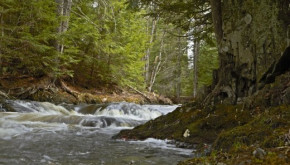
Article by guest author Pam Wells
My 1,000+ acre forest and its four miles of Sunkhaze stream through my forest’s center have been fortunate to receive support from Natural Resources Conservation Service (NRCS) as well as from UMaine students who are doing wildlife and forestry research. I also have created several teams which include my forester Kirby Ellis, local loggers, government funders, and wildlife/stream specialists from both state (Maine Inland and Fisheries) and NRCS. Because of those teams, I have been able to have a detailed forest management plan, 180 acres of pre-commercial thinning, roadwork repair, and the hope of stream habitat improvement for salmon and trout. And, the question I am often asked is, “How did you manage that?”
Have you ever participated in a “tailgate party?” You know… when everyone sits and eats on the back of a pickup truck. A little food, the outdoors and pretty trees and before long people are willing to share their thoughts and feelings. As a licensed clinical social worker, I can tell you that when you get people in their comfortable environment, they are better at relating and talking about what is going on. And when you invite the folks that are really smart about how to manage and work in your forest, you can learn a lot about how they view your forest and what they think might work well for your forest. And you can also tell them what you feel about their ideas and what is most important to you regarding your forest’s future.
Now here’s the trick. Most of these professionals have not done a tailgate tree party with both one another and the landowner present. Fortunately, for me, I have team members who are more than willing to try something new. And, as a consequence, I have had several tailgate tree parties in my forest.
Meeting one - What is our next forest project? A NRCS staff member, my forester, my logger, and I went out prior to road work and pre-commercial thinning project. I had my logger (who did my road work) actually pace the road work width and show me exactly how far he would remove brush abutting the forest. My NRCS member then was able to tell me how much they would help pay for the brush removal work. And my forester was able to talk with us about what trees would be best to keep or remove. One meeting with everyone on the same page proved to be a very efficient strategy.
Meeting two - Stream team strategy session… My stream team currently includes state and federal fish biologists and after inviting them to visit the stream for stream improvement possibilities, I decided to include my forester on that team. And guess what? All who attended were able to have a wonderful discussion regarding how forest management can impact stream habitat. And I learned a lot about how my decisions regarding my stream and forest can impact one another over time.
Since our first stream team meeting, there has been a Society of American Foresters tour, in my forest, where my stream team members educated foresters about what can help or hurt a stream. That was a brilliant idea suggested by my forester. My stream team crew continues to check the stream for habitat improvements possibilities and I have been fortunate enough to accompany them more than once; wading included.
Finally, we are not too far away from the University of Maine. I encourage all forestry/wildlife students in the area to use my forest as a research option. This year, I have had some ruffed grouse research students surveying in our forest. Prior years have included wide spacing crop tree release and this year will include spruce bud worm collection traps.
I also continue to apply for NRCS funding for forest and stream improvement. I may never obtain another funding approval, but at this point, I have been given a great deal of support by that agency to help improve the health of my forest.
A happy forest creates a happy landowner and a happy landowner takes care of a growing healthy forest. My suggestion to other forest owners is that should you desire help with forest improvement, don’t be afraid to participate, invite others to share your forest, ask a lot of questions and create a team that cares as much about the forest as you do.
And, oh yeah… Bring sandwiches and cookies to enjoy a fun tailgate party in your forest with your forest friends.

